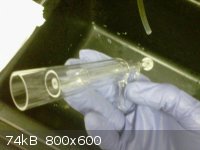
crazedguy - 1-12-2010 at 19:58
well i just read something else about a plasma torch which made me wonder if it is possible to make a plasma incinerator from a mircowave?
if you don't know what a plasma incinerator is http://en.wikipedia.org/wiki/Plasma_arc_waste_disposal
this would be just for fun nothing useful like real ones
if that wouldn't be possible how about a plasma torch to cut things with?
if you dont get what i am asking could you use a mircowave to produce plasma in a container to melt things?
DDTea - 1-12-2010 at 22:14
Basically, you want to use a microwave's magnetron to build a microwave induced plasma torch? Sounds awesome. You will need a tesla coil to create
the initial spark and some kind of carrier gas (Argon seems to be the preferred one), though. I don't know how well the plasma would be sustained
either.
crazedguy - 2-12-2010 at 05:10
yeah i know i need argon which i have 75/25 argon/CO2 for my welder which im not sure if that would work
but yeah thats the basic plan DDTea
if anyone else has some ideas so that i could put a plan together that would be sweet
aonomus - 2-12-2010 at 17:22
You'll have to make sure that your waveguide can actually focus the RF onto the torch portion.
A similar device exists, its known as an inductively coupled plasma torch for mass spectroscopy, and AAS/AES. Essentially an induction heater that
heats a spark and turns it into a plasma torch. It creates really hot temperatures (fused silica or quartz torches still require extra cooling argon
gas).
Argon is typically used as a carrier gas for ICPMS, AES/AAS because it is totally inert yet easily ionizable.
If you used CO2 in your plasma torch, you would probably end up having a slightly reducing atmosphere due to the extra carbon balance (with atomic
oxygen forming other oxides of carbon, nitrogen, etc) and probably coat an area in soot.
Additionally you will have to ensure there is minimal reflection of RF power back into the magnetron, they really don't like that.
crazedguy - 2-12-2010 at 18:59
well the only thing i could find on that seemed pretty complicated to build
so unless someone could think of an easy way or know of simple plans this wouldnt be feasible for me
kintekobo - 3-12-2010 at 11:19
I used to work on air defence radar systems. Very high transmitter power. We used to get plasma form in the waveguide when the dessicator went on the
fritz so it is theoretically possible. If memory serves it was a combination of events where moisture entered the waveguide and a standing wave had
formed causing a high power node to occur. Took about 50 MWatt to trigger it though so you might want to uprate the fuse in your microwave oven.
DDTea - 3-12-2010 at 13:13
Hah, you can use less than 50 MW and be OK for generating plasmas. Bear in mind, though, plasmas--especially ICP's--can be pretty expensive! DCP's
can cut out a lot of the cost. Not so sure about MIP's. Of course, I'm thinking on an industrial scale where these instruments are left online 24/7.
I'll attach a photo of a plasma torch (for an ICP-OES unit)--this is just the glass portion of it. If you can imagine this inside an instrument, the
induction coil is wrapped around the exterior of this glass. From the outlets perpendicular to the length of the tube come the flow of the argon
carrier gas. From the rear, in this particular instrument (there are some emission instruments that have the plasma perpendicular to the flow of
sample), comes the flow of sample from the nebulizer.
Can you see how this is going to work out for you yet? To actually light the plasma, though, there needs to be a little spark plug in there to
initially ionize some of the argon atoms. Once that has been achieved, the RF signal will create a sort of helical flow of current which eventually
creates an electron avalanche and a nice plasma. What I am unsure of is whether there is a relationship between the RF frequency and the
pressure/flow rate of argon to create a stable plasma--i.e., to be continuous and not simply flicker like a plasmoid in the microwave.

[Edited on 12-4-10 by DDTea]
crazedguy - 3-12-2010 at 16:03
well thanks for your input that definitely does help
what im really looking for is to make a somewhat sealed chamber that i can cook things in with plasma
what im trying to found out is that is it as simple as have the magnetron over a spark with a flow of argon gas or how hard would this be to do

